Latest posts by (see all)
- The Best Things to Do in Tulsa - June 26, 2020
- The Most Interesting Things to Do in Springfield Mo - June 15, 2020
- Best Things to Do in Salt Lake City - May 26, 2020
- 10 Best Websites for Playing Online Games - May 22, 2020
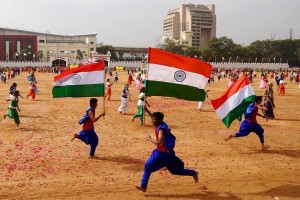 India is known as the country of the brightest colors and the most burning spices, the cradle of ancient civilization and the pearl of the English crown. In view of the unspeakably rich natural and cultural values, this is truly a unique country.
India is known as the country of the brightest colors and the most burning spices, the cradle of ancient civilization and the pearl of the English crown. In view of the unspeakably rich natural and cultural values, this is truly a unique country.
And indeed, those who have ever visited India celebrate its inherent fairytale atmosphere, as if it exists outside the usual world. And yet the sights of India are very real and valuable, and some of them even replenish the funds of the World Heritage of Humanity. The country’s natural wealth makes it an incredibly popular travel destination.
Since ancient times, other nations have sought to see all of its miracles with their own eyes. India can rightfully be called the most amazing and beautiful country in South Asia. The history of Indian civilization has more than 5000 years. World religions Buddhism and Hinduism were born here.
Contents
- Place to visit number 1: Taj Mahal
- Place to visit number 2: Bollywood
- Place to visit number 3: Water Kingdom
- Place to visit number 4: The Haji Ali Mosque
- Place to visit number 5: The Tomb of Humayun
- Place to visit number 6: Delhi National Museum
- Place to visit number 7: Shankar’s International Dolls Museum
- Place to visit number 8: Delhi Zoo
- Place to visit number 9: Happy Valley Tea Estate
- Place to visit number 10: The Bangalore Palace
- Video
Place to visit number 1: Taj Mahal
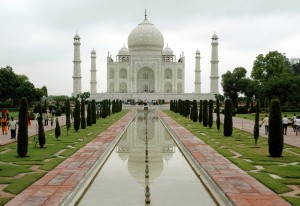 The most famous building on the territory of India, Taj Mahal is located in the city of Agra. It was erected in the XVII century on the bank of the river Jamna. Taj Mahal is a beautiful mausoleum built by a descendant of Tamerlan Shah Jahan in memory of his third wife Mumtaz-Mahal, who died during childbirth.
The most famous building on the territory of India, Taj Mahal is located in the city of Agra. It was erected in the XVII century on the bank of the river Jamna. Taj Mahal is a beautiful mausoleum built by a descendant of Tamerlan Shah Jahan in memory of his third wife Mumtaz-Mahal, who died during childbirth.
Today the Taj Mahal is considered not just a historical monument but also a symbol of love. The Mausoleum is the most amazing monument of Muslim architecture in India, dating back to the era of the reign of the Great Moguls.
Some facts to know:
- The construction of the mausoleum began in 1632 and lasted more than 20 years, finally ending in 1653.
- In total, more than 20,000 people were employed in the construction of the marble complex.
- Inside the mausoleum there are the graves of the spouses Shah Jahan and his beloved Mumtaz-Mahal.
- In height, the mausoleum reaches 74 meters, along its sides there are minarets.
The whole complex is dominated by a huge but not heavy-looking dome of the mausoleum, surrounded on the four sides by four smaller domes. The walls are lined with marble, encrusted with gems – turquoise, agate, malachite, etc. The area around is a magnificent and majestic park. On the sides of the mausoleum there are two identical mosques from red sandstone.
Interesting: Today, the Taj Mahal complex annually attracts several million tourists, many of whom are foreigners.
Back
Place to visit number 2: Bollywood
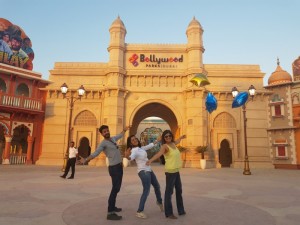 Bollywood – eight letters that have become sacred to all fans of Indian cinema. However, it should immediately be clarified that Bollywood (the habitat of the city of Bombay) – only a part of the giant called “India’s film industry.” Of the 1000 films that are produced in the country during the year, only slightly more than 200 account for this production center. The other two major film industries are:
Bollywood – eight letters that have become sacred to all fans of Indian cinema. However, it should immediately be clarified that Bollywood (the habitat of the city of Bombay) – only a part of the giant called “India’s film industry.” Of the 1000 films that are produced in the country during the year, only slightly more than 200 account for this production center. The other two major film industries are:
- Tollywood, which produces films in the Telugu language,
- and Colonwood with their films in Tamil.
The name “Bollywood” consisted of two words – the city of Bombay and American Hollywood, which became the prototype of its Indian counterpart.
Not so long ago, Indian cinema and Bollywood in particular celebrated its centenary. But here’s how the story of glorious films with singing, dancing and looking for their brothers on the moles of heroes began – it’s worth knowing more. The first full-length movie in India came out on big screens on May 3, 1913, was, of course, a black and white film called “Raja Harishchandra.”
Separately, it is worth talking about singing and dancing that attracted all Soviet women from the TV screens without exception. It turns out that similar to the opera and the sound of ultrasound at the same time the songs appeared in Indian cinema around the 1930s, and immediately captivated the hearts of the audience. Today in the films of Bollywood there are five to nine songs, although it seems that incomparably more. And their sense, like dancing, is one – to convey the whole range of feelings, beginning with hatred and ending with the euphoria of love. Dancing Bollywood inspired not one European director, in particular, and the director of “Moulin Rouge” Baz Luhrmann.
How to visit this region of singing and dancing dark-haired handsome men and beuties? Since 2011, Bollywood pavilions are open to tourists, you can get there during an ordinary excursion, which includes even a visit to the set. To get acquainted with the life of the heroes of your favorite movie on the other side of the screen was just like one-two-three. You come to the agency and buy an excursion and you are already in place, among the scenery and soffits, make-up artists and extras walk around Bollywood. The large film set of Film City includes pavilions of many famous Indian film studios. Excursions are also held here, but it’s much more interesting to get here in the role of extras.
Interesting: All you need to do to find yourself at the studio is to come in the evening to the Kolaba district at the Leopold`s cafe or at the Red Shield Salvation Army guest house. Here, tourists are constantly offered a walk to the film studio.
Back
Place to visit number 3: Water Kingdom
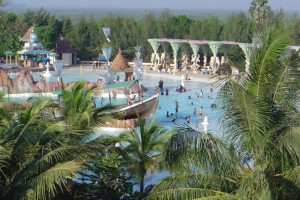 Water Kingdom built in 1998, belongs to the Essel World amusement park in Mumbai and is considered one of the most beautiful in Asia. The whole territory is divided into 5 parts:
Water Kingdom built in 1998, belongs to the Essel World amusement park in Mumbai and is considered one of the most beautiful in Asia. The whole territory is divided into 5 parts:
- “Wetlanik” is a wave pool stylized under a fairytale island with many slides, fountains and ships, as if stranded. Waves are not so strong as to be feared, besides, rescuers are always on duty in the park.
- “MissPhisly Hill” – a complex of descents with steep turns for true lovers of extreme sports. Children are allowed here only accompanied by adults.
- “Lagoon” is a shallow play pool with a lot of different sprinklers and low slides. Its area is 30 thousand square meters. There is no larger than this one in India. In the hot Mumbai water park is extremely popular, so plan to visit it better on weekdays in the morning. “Lagoon” is suitable for families: there are three children’s, three adults and four family slides, as well as waterfalls, cascades and sprinklers, the most notable of which is the 500-liter elephant.
- “Adventure Amazonia” – a channel with the flow, imitating a wild river. Along it there are several hills, tunnels, cascades and water cannons. There is also a vertical descent resembling a real waterfall. The speed of falling from it is more than 60 km / hour.
Interesting: For toddlers there is a special shallow pool with sprinklers, where it you can leave them alone and not worry.
Back
Place to visit number 4: The Haji Ali Mosque
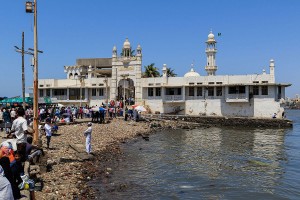 The Haji Ali Mosque is a sacred place for Sunni Indians, and for the rest it is one of the main local attractions. It was built in memory of a rich Muslim merchant who distributed all his property before the pilgrimage to Mecca, to which he never reached, having perished on the way. His body was returned to Mumbai and buried on the island, where later, in 1431, a mosque bearing his name was erected. There is another version: after the Hajj he continued his wanderings, performed miracles and was ranked among the saints.
The Haji Ali Mosque is a sacred place for Sunni Indians, and for the rest it is one of the main local attractions. It was built in memory of a rich Muslim merchant who distributed all his property before the pilgrimage to Mecca, to which he never reached, having perished on the way. His body was returned to Mumbai and buried on the island, where later, in 1431, a mosque bearing his name was erected. There is another version: after the Hajj he continued his wanderings, performed miracles and was ranked among the saints.
Haji Ali stands on an island connected to the mainland by a narrow road that appeared in 1944. Earlier it was possible to reach it only by boat, as now during tides. Along the road there are a lot of tents with souvenirs, local food and drinks, beggars begging, and goats just walking.
Do not walk on the dam on foot, if the water level rises – the sea here is very dirty, and there are no side fences.
At the entrance to the island there are gates of white marble. The whole complex is quite large, its area is about 4.5 sq. km. White domes and a minaret 26 m high are made in the architectural style typical of the Mughal empire. In the main hall there is the tomb of Haji Ali, decorated with a silver crown and brocade, marble columns with the names of Allah and colored mosaic.
There are two more halls:
- eastern for me;
- western for women.
Interesting: The mosques of Haji Ali are badly damaged by salty winds, so it is in danger of total destruction. There is a plan to demolish the sights and build it anew from more durable white marble.
Back
Place to visit number 5: The Tomb of Humayun
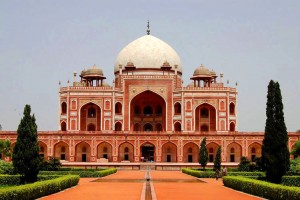 The tomb of Humayun is an amazingly beautiful mausoleum of one of the Great Moguls, padishah Humayun, located in the heart of the country – Delhi.
The tomb of Humayun is an amazingly beautiful mausoleum of one of the Great Moguls, padishah Humayun, located in the heart of the country – Delhi.
Some historical facts:
- The tomb was built by the order of the Padishah widow Hamida Banu Begum in 1562.
- The construction lasted 8 years, the architects of the project are Said Muhammad and his father Mirak Giyahuddin.
- It is believed that the architecture of the tomb was strongly influenced by the infatuation of his son and father with Samarkand constructions of the Timurids.
If to believe the legend, the death of the padishah was rather strange but extremely interesting. It is said that Humayun was an educated man, he honored science, especially astronomy and astrology. Once, returning from his library with a large pile of books, he heard a call to prayer – azan. Humayun did not want to throw the books, so he tried to kneel with the pile in his hands. Suddenly he rolled down the stairs and soon died from the injuries. Despite its not a very life-affirming destination, the tomb should not be overlooked – it truly is one of the most grandiose and majestic sights of Delhi. A fine example of early Mughal architecture, it is considered the prototype of the Taj Mahal.
It is worth saying a few words about the exterior of the crypt. This majestic building was made of red sandstone, elegantly decorated with geometric elements of white and black marble and window grilles “jali”. Around there are traditional Mughal symmetrical gardens “charbag”.
Interesting: Today Humayun’s tomb is included in the Unesco World Heritage List.
Back
Place to visit number 6: Delhi National Museum
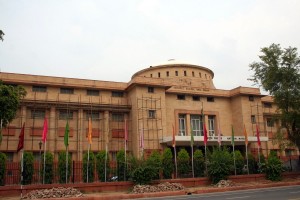 First of all, when you find yourself in Delhi it is worth visiting the National Museum, which was opened in the middle of the last century. There were about forty thousand exhibits then and today the collection has increased several times. Here you can do a lot of interesting things:
First of all, when you find yourself in Delhi it is worth visiting the National Museum, which was opened in the middle of the last century. There were about forty thousand exhibits then and today the collection has increased several times. Here you can do a lot of interesting things:
- learn about the history of the formation of the Indian state,
- get acquainted with its cultural and natural wealth.
- see many exhibits, among which the most interesting there are old handmade fabrics, objects for cult ceremonies of precious metals, various temple sculptures, national Indian costumes, as well as items found during archaeological excavations.
To get acquainted with all the museum values, it is better to come to the opening, and then you, maybe, will have time to bypass all the way to the end of the working day.
Interesting: Experienced guide-consultants are constantly working here, and interesting and informative documentaries are periodically shown.
Back
Place to visit number 7: Shankar’s International Dolls Museum
![]() If you are fond of hand-made then a huge collection of dolls from around the globe, collected by Shankar Pillai won’t leave you indifferent. Shankar Pillai is known as a famous journalist and master of cartoons. You have a chance to get acquainted with the great collection in the International Museum of Dolls named after Shankar.
If you are fond of hand-made then a huge collection of dolls from around the globe, collected by Shankar Pillai won’t leave you indifferent. Shankar Pillai is known as a famous journalist and master of cartoons. You have a chance to get acquainted with the great collection in the International Museum of Dolls named after Shankar.
The history of the museum starts from the moment when Shankar Pillai received a doll from the Hungarian ambassador in a Hungarian national costume. After this moment Shankar began to bring dolls from around the world, and soon his collection already numbered more than 500 dolls. Today the collection has more than 6,500 exhibits collected in 85 countries. The museum has a workshop where Indian dolls are made for museum expositions, as well as for sale to world museums or for exchange.
The process of the dolls’ production includes:
- Preparation of a prick of a special paste,
- the basis is made of clay, plant components, natural resins and special substances that contribute to the long storage of exhibits.
The creation of each sculpture is preceded by a scrupulous study of the subject – the doll is depicted in dance, during a domestic or religious rite, the external and psychological appearance of a representative of the nationality is carefully studied. No doll contains unreliable or accidental details, because reproducing the image of the divine creation its distortion by inaccuracies is unacceptable.
Interesting: Here visitors will see dolls from European, Asian, African countries and countries of the Middle East. The collection is decorated with brightly costumed Indian dolls, among which dolls in bride’s outfits stand out.
Back
Place to visit number 8: Delhi Zoo
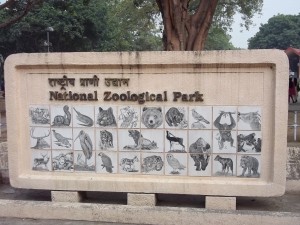 The idea of zoo creation in Delhi originated in the distant 1952. Then the Indian Wildlife Council stated the need to create a large zoological center that would pursue the goal of preserving the rich diversity of wildlife. The development of the zoo project took more than seven years. The official opening of the Delhi Zoo was held on November 1, 1959, and in 1982 it was given the status of a national one.
The idea of zoo creation in Delhi originated in the distant 1952. Then the Indian Wildlife Council stated the need to create a large zoological center that would pursue the goal of preserving the rich diversity of wildlife. The development of the zoo project took more than seven years. The official opening of the Delhi Zoo was held on November 1, 1959, and in 1982 it was given the status of a national one.
The territory of the Delhi zoo is ennobled with rich vegetation and artificial lakes. Between them there is a wide trail with signs, the recommended zoo route. During the walk you will get acquainted with a magnificent collection of animals from all over the world. The Delhi Zoo has a large collection of monkeys, artiodactyls, felines, reptiles, birds.
And, of course, there were elephants, rhinoceroses, hippos and giraffes, which always remain in the public’s attention. The total number of pet zoo reaches 2.5 thousand individuals.
The Delhi Zoo has adopted an initiative to conserve a population of endangered species of animals. Among the priority areas is the Asian lion due to the fact that there are no more than 300 individuals in nature remained. The same situation is with the Bengal tiger and the Indian rhinoceros, the number of which is rapidly decreasing due to poaching. Deer-lira, a deer with twelve horns, is listed in the International Red Book.
For the comfort of visitors in the zoo there are special recreation areas:
- The territory is equipped with benches, drinking water sources and toilets.
- The local kiosks sell drinks and ice cream.
- Superfluous things that you do not want to carry can be left in the storage room.
- Free wheelchair access is available for wheelchair users.
- And for an additional fee along the route of the zoo you can ride an electric car.
Interesting: Zoo is divided into blocks, in each of which a certain kind of animals resides. Everywhere you can see information bulletins containing interesting facts about the exhibits.
Back
Place to visit number 9: Happy Valley Tea Estate
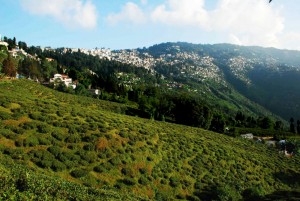 Happy Valley Tea Estate is located at an altitude of 2750 m above sea level and is one of the most high-altitude plantations in the world. Here there is elite Indian type of tea – Darjeeling, which got its name because of the place of its growth – in the vicinity of the city of the same name. The variety is valued for its refined,
Happy Valley Tea Estate is located at an altitude of 2750 m above sea level and is one of the most high-altitude plantations in the world. Here there is elite Indian type of tea – Darjeeling, which got its name because of the place of its growth – in the vicinity of the city of the same name. The variety is valued for its refined,
slightly tart taste. Happy Valley Tea Garden, founded in 1854, has copies of tea bushes that are over 150 years old.
In the garden you can enjoy:
- observing the process of collecting and processing tea,
- visiting the company store to buy Darjeeling tea, which is almost all exported.
A pack of tea in the store at the garden will cost 225 rupees per 100 grams, tasting – 25 rupees for a cup of tea.
Interesting: The best time for visiting is the periods of gathering tea leaves: March – May and June – November.
Back
Place to visit number 10: The Bangalore Palace
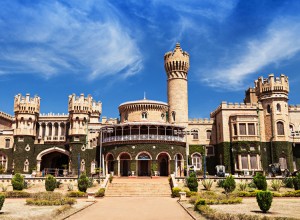 Bangalore Palace is a unique Tudor palace, remarkable for being a small copy of the famous English Windsor Castle. The palace was erected in 1862 – 1944, it has a luxurious interior decoration, combining various European and oriental architectural styles. Bangalore Palace is located in the Palace Gardens, in the heart of the rich in the sights of the Indian city of Bangalore. It strikes with its splendor and luxurious decoration.
Bangalore Palace is a unique Tudor palace, remarkable for being a small copy of the famous English Windsor Castle. The palace was erected in 1862 – 1944, it has a luxurious interior decoration, combining various European and oriental architectural styles. Bangalore Palace is located in the Palace Gardens, in the heart of the rich in the sights of the Indian city of Bangalore. It strikes with its splendor and luxurious decoration.
The interior is decorated with:
- rich paintings,
- skilful wood carvings,
- works of art.
At the moment, the palace is owned by the descendants of the Maharajas of Mysore from the Vodeyarov dynasty, who provide the palace premises for various festive events, conferences, festivals and exhibitions. The Palace is open to tourists.
In the middle of the palace square there is an inner courtyard, which is laid out with a fluorescent ceramic tile of blue color. Near the courtyard there is a large and magnificently decorated ballroom, where in the Tsarist times banquets were held. Another unique hall is called Durbar Hall, it was intended for holding various meetings. Its walls are decorated with elegant paintings. A huge statue depicting the head of an elephant stands there.
Interesting: On one of the walls of Durbar Hall you can see a series of windows, which are decorated with stained glass. All the inner palace chambers are full of bright colors, among which you can see yellow, blue, red and green predominating.
Back